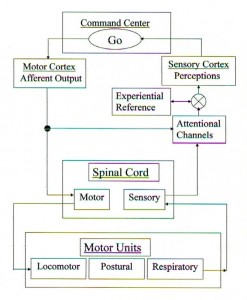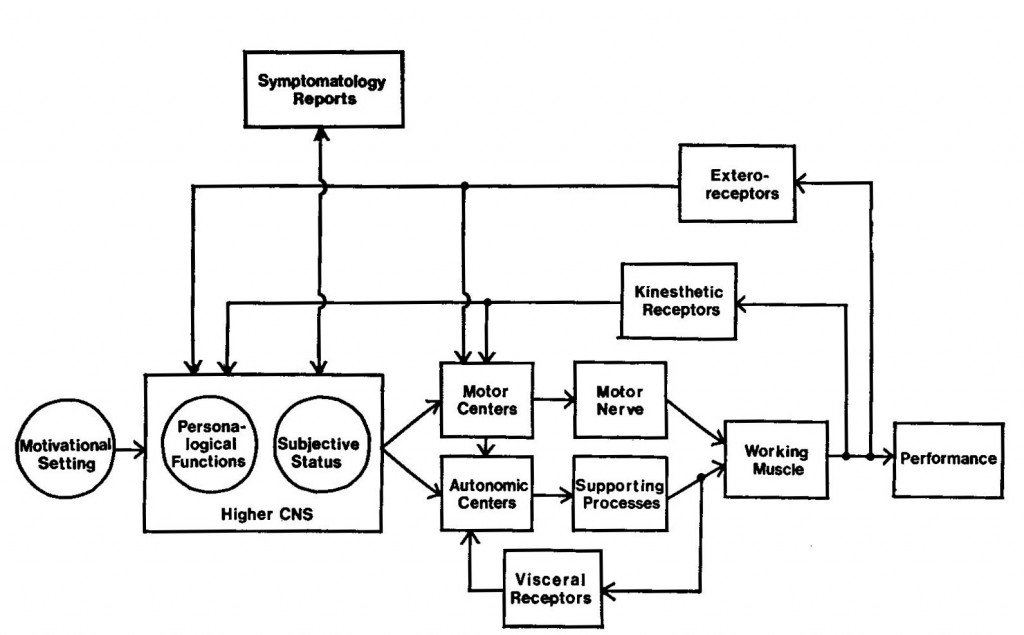ARTICLE 1
How are the Motor and Support Systems Organized and Activated?
What are the specific mechanisms involving critical elements? This article begins our hunt by describing the overall architecture and operation of systems powering our gait when running and cycling.
Before this article dives into recent advances in exercise neurobiology, some of you may want to review the basics of organization and control of motor performance. Feel free to download a chapter I wrote in 1974, “Interrelationships of the Motor and Metabolic Support Systems during Work and Fatigue”. That chapter was published in Simonson’s second book in his Work Capacity and Fatigue Series (Simonson & Weiser, 1976). From here on, this article will be reorganizing and updating that chapter.
(Download PDF file of Chapter)
Let’s condense and update that chapter. First, current knowledge is briefly summarized for the locomotor processes regulating initiation, maintenance, and modifying gait. Then, of course, an update is made for the nutritional, perceptual, motivational, emotional, and other systems supporting the locomotor command center, motor units, and motor sensory neurons that help us move along. Along the way, we will ask and reask the following questions: How do our motor and support systems work together, and where are the weak links?
Let’s begin with Figure 1 that is my 2008 locomotor schema modified from we presented in 1976 at the Borg Symposium. It describes how we are organized and operating as we begin to walk, run, or cycle.

Figure 1 Locomotor signal processing (2008 Model)
“Go” is the conscious or unconscious feedforward signal from our locomotor command center to start, speed up, slow down, or maintain moving along. Various parts of the “motor” cortices sends an output signal down neural pathways, part shared with other cortical structures, like the midbrain autonomic and locomotor centers with the rest going down to the spinal cord. Motor neurons in the spinal cord signal their group of muscle fibers to contract at crucial points of the gait cycle.
In and around the muscles and in joints, nerve endings track the resulting movement and signal their neurons in the spinal cord. They feed their information back to motoneurons and up through attentional channels to a comparator, i.e., the circle with an “X” inside, and to nutritional, motivational, emotional, and other systems. At the comparator, this information is matched to memorized prior experiences; the resulting degree of matching is sent to the command center.
Now, it’s time to reintroduce the supporting processes.
First of all, let me review the concept of a physiological meta-system. By itself, a system is a functionally related group of interacting, interrelated, and interdependent elements. And a meta-system is a complex collection of systems.
Our locomotor meta-system is made up of all the systems and their processes that enable motor activity. Indeed, our gait only involves a part of that meta-system: those systems that operate the working muscles. But there is another part of that meta-system, and it just supports our working muscles. Confusing? Now it is time for a bottoms-up discussion.
- Supporting Systems: Of course, active cells require both intracellular and extracellular supply of fuel and oxygen plus must eliminate carbon dioxide and other wastes. Let’s remember what’s involved; the muscle’s metabolism using and mobilizing fatty acids and glucose, the transfer of fuel into the muscle, delivering new fuel into the blood stream, the circulation, the intake and exhalation of air, more circulation, the GI tract, the kidneys, and so forth. Information about these metabolic systems is signaled from chemoreceptors, other interoreceptors, etc. to support-controlling systems in the central nervous system (CNS) and is also sent to hormonal systems.Homeostasis is the objective
Sustaining steady state - Gait
management and supervision of motor action arises from the action of working muscles and is controlled by motor-coordinating and support-coordinating systems of the CNS which are shown much oversimplified in Figure 2 as motivational, personalogical, perceptual, and subjective influences. Consequently, the motoneuron and muscle contractile apparatus act as the controlled system whose function is motor action. Muscle spindles, tendon organs, and other mechanoreceptors detect changes in skeleto-muscular tension and position. They function as the detectors of the motor-controlling system and feed information back along the afferent pathways to the spinal cord and to the motor centers of the higher levels of the central nervous system (CNS).collection of supporting the motor-[controlling] system
pace leading edge
The model below will be our guide in finding many of the weak links. Note there is no separation between mind and body.

Figure 2 Locomotor Meta-System
Figure 2. Schematic diagram of motor performance with some of its control systems and signaling loops.
How do our motor and support systems work together and where are the weak links?
Gait and Coordination
- Locomotor Manager – our own endurance performance, as a whole, arises from the combined action of many systems. This integrated meta-system, if you will, is shown, much oversimplified, in Figure 2. Many scientists emphasize the locomotor system that is sustained by several metabolic support systems. Other systems are included and identified as personalogical functions and subjective status, along with the motivational setting, and symptomatology reporting. The whole system functions to initiate and to maintain or modify motor patterns like our gait when walking, running, and cycling.
- Locomotor Performer – actor runs the automated pattern regulation with information about the activity of numerous controlled [metabolic] systems supporting the motor-[controlling] system is fed from chemoreceptors and other interoreceptors to support-controlling systems in the CNS and is also fed to hormonal [control] systems.fight-or-flight
basal ganglia, cerebellar locomotor center, mesencephalic locomotor center
visual, audio, and kinesthetic input - Limb Leader – regulation of the limb central pattern generator
thoracic and lumbar hemi-spinal cord CPGs - Motor Unit Worker – the muscle cell, the motor centers, motoneurons, and muscle contractile apparatus act as the controlled system whose function is to help us move. This flow of information and action drives motor activity. Some would call this feedforward regulation. Muscle spindles, tendon organs, and other mechanoreceptors detect changes in skeleto-muscular tension and position. They function as the detectors of the motor-controlling system and feed information back along the afferent pathways to the spinal cord and to the motor centers of the higher levels of the central nervous system (CNS).
Supraspinal mechanisms regulating changes in gait and medullary/spinal motor pattern generating gait will be described.
Metabolic Support
Cardio-Pulmonary Support
Motivational Support